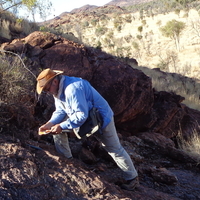Papers by Elena Belousova
... Chris Kirkland, Sandra Romano, Michael Doublier Geological Survey of Western Australia (GSWA)... more ... Chris Kirkland, Sandra Romano, Michael Doublier Geological Survey of Western Australia (GSWA), 100 Plain Street, East Perth 6004 ... in (a): SS Sandstone; MC Marda Complex; SC Southern Cross; FO Forrestania; LJ Lake Johnston; RAV Ravensthorpe; AW Agnew ...
The Nizhny Tagil zoned-type massif located in the Middle Urals is associated with world-class pla... more The Nizhny Tagil zoned-type massif located in the Middle Urals is associated with world-class platinum-group elements (PGE) placer deposits. The Os-isotope results identify a restricted range of 187 Os/ 188 Os values of laurite, Os-rich alloys and chromitite. Similarly 'unradiogenic' 187 Os/ 188 Os values are indicative of a common near-to-chondritic source for the PGE. The compositional and isotope-geochemical results provide new insights into ore genesis and temporal evolution of ultramafic rocks of the Uralian Platinum Belt.

Geological Society of America Special Papers, 2015
ABSTRACT ABSTRACT The Mesoarchean Kola-Karelia continent in the eastern Fennoscandian Shield incl... more ABSTRACT ABSTRACT The Mesoarchean Kola-Karelia continent in the eastern Fennoscandian Shield includes three tectonic provinces, Kola, Karelia and Belomoria, that were formed by the Paleoarchean and Mesoarchean microcontinents. Traces of Mesoarchean tonalite-trondhjemite-granodiorite (TTG)−type early crust were documented in all of the most ancient units of the Kola-Karelia continent. Ancient crust was revealed and dated in the Ranua and Iisalmi microcontinents, 3.5–3.4 Ga; Vodlozero and Khetolambina microcontinents, 3.25–3.15 Ga; Kuhmo-Segozero microcontinent, ~3.0 Ga; Murmansk and Inari-Kola microcontinents, 2.93 Ga; and Kianta microcontinent, 2.83–2.81 Ga. In the older (>3.0 Ga) tectonic units and microcontinents, the ancient crust was possibly formed in brief bursts of endogenic activity. In younger microcontinents (3.0–2.93 Ga), these processes could continue until 2.8 and even 2.72 Ga. The tectonic settings in which early TTG crust has been produced are largely uncertain. The primary melt glassy inclusions with a glass phase in cores of prismatic zircon crystals from TTG gneisses provide evidence for the volcanic origin of gneiss protolith. Suggested genetic modeling of TTG-type complexes assumes that felsic K-Na melts with positive Eu anomaly are a product of dry high-temperature partial melting of the previously formed mafic-to-felsic crustal rocks and/or thick older TTG crust. Positive Eu anomaly in the eutectic is directly related to the predominance of plagioclase and K-feldspar in the melt. TTG-type crust melted to produce granitegranodiorite (GG) rocks. Earliest microcontinents are separated by Mesoarchean greenstone belts (mainly 3.05–2.85 Ga, in some cases up to 2.75 Ga), which are fragments of paleo–islandarc systems accreted to their margins: the Kolmozero-Voronya, Central Belomorian, Vedlozero-Segozero, Sumozero-Kenozero, and Tipasjärvi-Kuhmo-Suomussalmi belts; and the mature island arcs (microcontinents): Khetolambina and Kovdozero. These structural units are characterized by significant extent, close to rectilinear trend, localization along the boundaries between Archean microcontinents, and a specific set of petrotectonic assemblages (basalt-andesite-rhyolite, komatiite-tholeiite, and andesite-dacite associations). The recently discovered Meso-Neoarchean Belomorian eclogite province that is structurally linked with the Central Belomorian greenstone belt contains two eclogite associations distributed within TTG gneisses: the subduction-type Salma association and the Gridino eclogitized mafic dikes. The protolith of the Salma eclogites is thought to have been a sequence of gabbro, Fe-Ti gabbro, and troctolite, formed at ca. 2.9 Ga in a slow-spreading ridge (similar to the Southwest Indian Ridge). The main subduction and eclogite-facies events occurred between ca. 2.87 and ca. 2.82 Ga. Mafic magma injections into the crust of the active margin that led to formation of the Grigino dike swarm were associated with emplacement of a mid-ocean ridge in a subduction zone, beginning at ca. 2.87 Ga. Crustal delamination of the active margin and subsequent involvement of the lower crust in subduction 2.87–2.82 Ga ago led to high-pressure metamorphism of the Gridino dikes that reached eclogite-facies conditions during a collision event between 2.82 and 2.78 Ga. This collision resulted in consolidation of the Karelia, Kola, and Khetolamba blocks and formation of the Mesoarchean Belomorian accretionary-collisional orogen. To date, the subductionrelated Salma eclogites provide the most complete and meaningful information on the nature of plate tectonics in the Archean, from ocean-fl oor spreading to subduction and collision. The Kovdozero granite-greenstone terrain that separates the Khetolambina and Kuhmo-Segozero microcontinents is formed by TTG granitoids and gneisses hosting metasediments and metavolcanics of several greenstone belts, which belonged to the Parandovo-Tiksheozero island arc that existed from ca. 2.81 to 2.77 Ga. The Iringora greenstone belt includes the ophiolite complex of the same name with an age of 2.78 Ga. The collision of microcontinents resulted in the upward squeezing of the island arc and the obduction of its marginal portions onto surrounding structures. Mints, M.V., Dokukina, K.A., Konilov, A.N., Kaulina, T.V., Belousova, E.A., Dokukin, P.A., Natapov, L.M., and Van, K.V., 2015, Mesoarchean Kola-Karelia continent, in Mints, M.V., Dokukina, K.A., Konilov, A.N., Philippova, I.B., Zlobin, V.L., Babayants, P.S., Belousova, E.A., Blokh, Y.I., Bogina, M.M., Bush, W.A., Dokukin, P.A., Kaulina, T.V., Natapov, L.M., Piip, V.B., Stupak, V.M., Suleimanov, A.K., Trusov, A.A., Van, K.V., and Zamozhniaya, N.G., East European Craton: Early Precambrian History and 3D Models of Deep Crustal Structure: Geological Society of America Special Paper 510. MANUSCRIPT ACCEPTED BY THE SOCIETY 7 OCTOBER 2014; published online January 29, 2015;p. 15–88, doi:10.1130/2015.2510(02). For permission…
... References Belousova EA, Griffin WL, Walters SG & O'Reilly SY 2001. ... Abstract, 20... more ... References Belousova EA, Griffin WL, Walters SG & O'Reilly SY 2001. ... Abstract, 2001: A Hydrothermal Odyssey, Townsville, Queensland, 17 - 19 May 2001 Griffin WL, Belousova EA, O'Reilly SY & Walters SG, 2004. TerraneChronTM: new light on crustal evolution. ...











Uploads
Papers by Elena Belousova